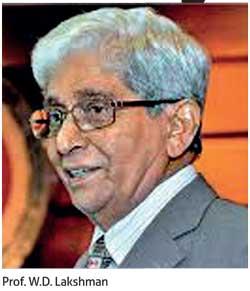Reply To:
Name - Reply Comment
By Nishel Fernando
While dismissing the ‘doom and gloom predictions’ of international agencies, the Central Bank (CB) expects a marked improvement in Sri Lanka’s macroeconomic fundamentals this year, under the government’s ‘alterative policy’, recovering from the impacts of the pandemic, last year.

“As a result of the policies we adopted, we expect the economic growth to end up in the 5.5 percent-6 percent range in 2021,” CB Governor Prof. W.D. Lakshman told reports in Colombo, yesterday.
He noted that the positive outlook was due to several reasons, including low base effect, less stringent restrictions imposed in the second COVID-19 wave, opening up of the country’s borders for tourism, on-going vacation drive as well as the positive global economic outlook projections for the year.
The CB estimates the country’s economy to have contracted by 3.9 percent in 2020.
Further, he noted that the domestic investments have started to pick up, as seen in the Purchasing Managers Index and Business Outlook Survey.
The CB projected the private sector credit to grow by Rs.850 billion this year.
He urged the international agencies to look at the country’s prospects in a positive view, before arriving in negative projections, based on their political or ideological motives, while criticising the government’s ‘alternative policy’ approach.
He also pointed out that most of such negative analysis and critiques were based on the economic performance in the second quarter of 2020, while pointing out that the conditions for this year would be different. The CB expects the per capita GDP to reach US $ 4,000 at the end of the year.
On the external sector, the CB expects the country to record a current account surplus of US $ 500 million at the end of this year.
Prof. Lakshman noted that the country recorded its first surplus in the current account in the third quarter of last year, since 1977.
The CB expects the country’s exports to reach US $ 13 billion this year, with a US $ 6 billion contribution from apparel, US $ 1.5 billion contribution from tea and US $ 1 billion contribution coming from gem and jewellery exports.
It expects the country’s import bill to remain around US $ 17 billion, on the assumption that crude oil would remain at US $ 60 per barrel on average this year.
In addition, it expects to earn US $ 1.75 million from services such as IT/BPP and US $ 1.75 billion from tourism earnings.
Further, it expects worker remittance inflows to grow to US $ 7.5 billion this year and foreign direct investments to recover to US $ 2 billion while expecting additional US $ 1 billion from the Colombo Port City lease sales.
Meanwhile, the CB plans to maintain the country’s foreign exchange reserves at US $ 5.5 billion, at end-2021.
While assuring that Sri Lanka would maintain its unblemished record in honouring debt repayment obligations, the Governor stressed that it’s not justifiable to determine the country’s debt-repaying capacity solely based on foreign reverses.
He noted that negotiations are currently underway with several foreign agencies, including multilateral lenders, foreign central banks and foreign commercial banks, to secure funding.
The CB expects the foreign debt component in the central government debt to decline to 35 percent in 2021.